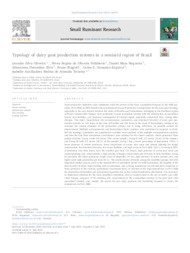Typology of dairy goat production systems in a semiarid region of Brazil.
Typology of dairy goat production systems in a semiarid region of Brazil.
Author(s): OLIVEIRA, L. S.; FELISBERTO, N. R. de O.; NOGUEIRA, D. M.; SILVA, A. F.; BIAGIOLI, B.; GONZALEZ-ESQUIVEL, C. E.; TEIXEIRA, I. A. M. de A.
Summary: Abstract: Socio-productive initiatives that culminated with the advent of the Food Acquisition Program in the Milk modality (PAA Milk) in 2003 boosted the development of Local Productive Arrangements for the dairy goat farming, especially in the area located between the states of Paraíba and Pernambuco, belonging to the Northeast region of Brazil. Considerable changes were performed in goat production systems with the introduction of specialized breeds, new facilities, and increased consumption of external inputs, especially concentrate feed, among other changes. This study characterized the socioeconomic, productive, and structural diversity of dairy goat production systems on 334 farms in the state of Paraíba and 220 farms in the state of Pernambuco aiming to understand the current situation of the production systems and to bring reflections on possible actions for improvement. Multiple correspondence and hierarchical cluster analyses were performed in sequence to establish the typology. Qualitative and quantitative variables were analyzed in the multiple correspondence analysis, and then the first three dimensions (coordinates) were retained for the cluster analysis, which generated three groups of farms: Group I with 216 farms (39% of the sample), Group II with 127 farms (22.9% of the sample), and Group III with 211 farms (38.1% of the sample). Group I had a lower percentage of landowners (34%), a lower presence of retired producers, lower frequencies of cactus pear areas and annual planting for forage conservation, low livestock diversity, few water facilities, and high access to PAA Milk ( 92%). In Group II, 80% of producers own their farms, have the smallest goat herd (18 heads), high presence of cactus pear areas and annual planting, and, consequently, a high practice of forage conservation and diversity of water facilities. Group III presented the oldest producers, larger areas of properties (41 ha), high presence of native pasture area, and higher daily milk production per farm (21 L). The results showed diversity among the identified groups, but with important similar aspects, such as the introduction of specialized breeds for milk production, the fragility of the feed security of herds, high stocking rates of ruminants, and a strong dependence on external feeds compared to those produced in the systems, particularly concentrate feeds, in addition to the high dependence on PAA Milk for production distribution and production stagnation due to few commercialization alternatives. It is necessary to implement solutions for the main identified distortions, such as improvement in the use of native and cultivated forages, adequacy of the stocking rate, reassessment of the composition strategy of the goat herd with specialized animals, and, mainly, the search for new dairy products and marketing channels to reduce the dependence on PAA Milk.
Publication year: 2022
Types of publication: Journal article
Unit: Embrapa Goats & Sheep
Observation
Some of Embrapa's publications are published as ePub files. To read them, use or download one of the following free software options to your computer or mobile device. Android: Google Play Books; IOS: iBooks; Windows and Linux: Calibre.
Access other publications
Access the Agricultural Research Database (BDPA) to consult Embrapa's full library collection and records.
Visit Embrapa Bookstore to purchase books and other publications sold by Embrapa.

